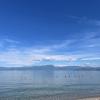For this blog, I thought I would share some fascinating information about the history of Siena, and its unique charm that sets it apart from its neighboring cities like Florence. Siena boasts an incredible amount of preserved culture dating back to the Middle Ages, and I have had the privilege of learning about this rich history through our Italian student companions, classes, and instructors.
One of the most distinctive features of Siena is its system of contrade, or districts. Each contrada is a self-contained community within the city, complete with its own flag, statues, museum, traditions, and more. There are 17 contrade in Siena, and they have been a vital part of the city's social fabric since the Middle Ages. The contrade foster a deep sense of community and pride among their residents. People often know most of the other families in their contrada, and this close-knit environment is celebrated with various events such as contrada dinners and parties. Our student group was fortunate enough to be invited to a contrada dinner by our director Vittoria, which was an incredible experience!
The contrada that I lived in was the Onda, symbolized by a dolphin and a wave with a blue and white background. Spending a few months immersed in the culture of the Onda contrada has been an unforgettable experience. One of my favorite traditions is seeing all of the flags hung up in the streets when a new baby is born. Additionally, the contrada hosts frequent barbecues and gatherings.
The sense of identity and belonging that the contrade provides is noticeable. Each contrada has a rich history and unique stories that are passed down through generations. The rivalry and camaraderie among the contrade come to a head during the famous Palio di Siena, a historic horse race held twice a year in the Piazza del Campo. This event is not just a race but a significant cultural celebration that involves the entire city. Each contrada competes fiercely, and the race is preceded by parades in medieval costume, flag throwing, and drumming. The Palio is more than just a sporting event; it is a manifestation of centuries-old rivalries and alliances, with each contrada passionately supporting its horse and jockey. The excitement and pride of the residents is obvious, and winning the Palio is considered the highest honor.
In addition to the contrade, Siena is home to many historical landmarks that are a testament to its past. The Siena Cathedral is one of the most stunning examples of Italian Gothic architecture. Its facade, adorned with sculptures and mosaics, and the breathtaking interior featuring works by artists such as Michelangelo and Donatello. Siena is also known for its delicious cuisine, including dishes like pici, a thick hand-rolled pasta and desserts such as panforte, a dense fruit and nut cake, and ricciarelli, soft almond cookies.
Living in Siena has allowed me to experience firsthand the deep-rooted traditions and vibrant community life that make this city so special. The pride and passion that Sienese people have for their contrade are evident in every aspect of their daily lives, from the way they celebrate milestones to how they support each other in times of need. It's a living testament to the enduring legacy of Siena's medieval past and a reminder of the importance of community and tradition in shaping our identities; I am so happy to have been able to be a part of a place like this.

Grace Wolf
Hi! I’m Grace. I'm a first-generation, Morehead-Cain Scholar at the University of North Carolina-Chapel Hill studying Economics and Environmental Science. I was raised in Appleton, Wisconsin, and I am an active scuba diver, yogi, and gardener.





